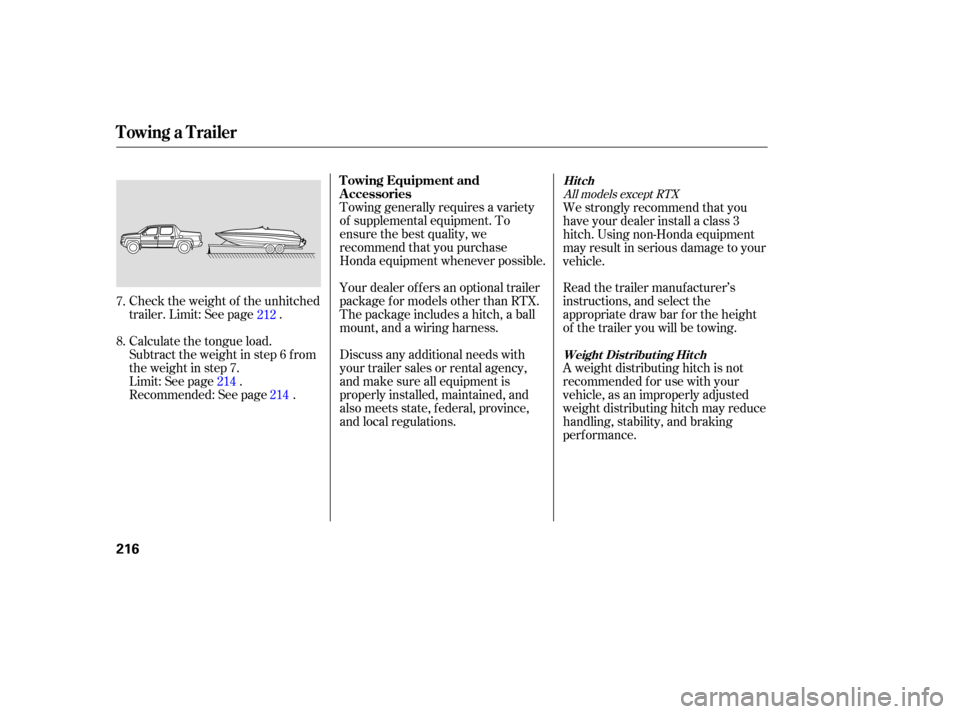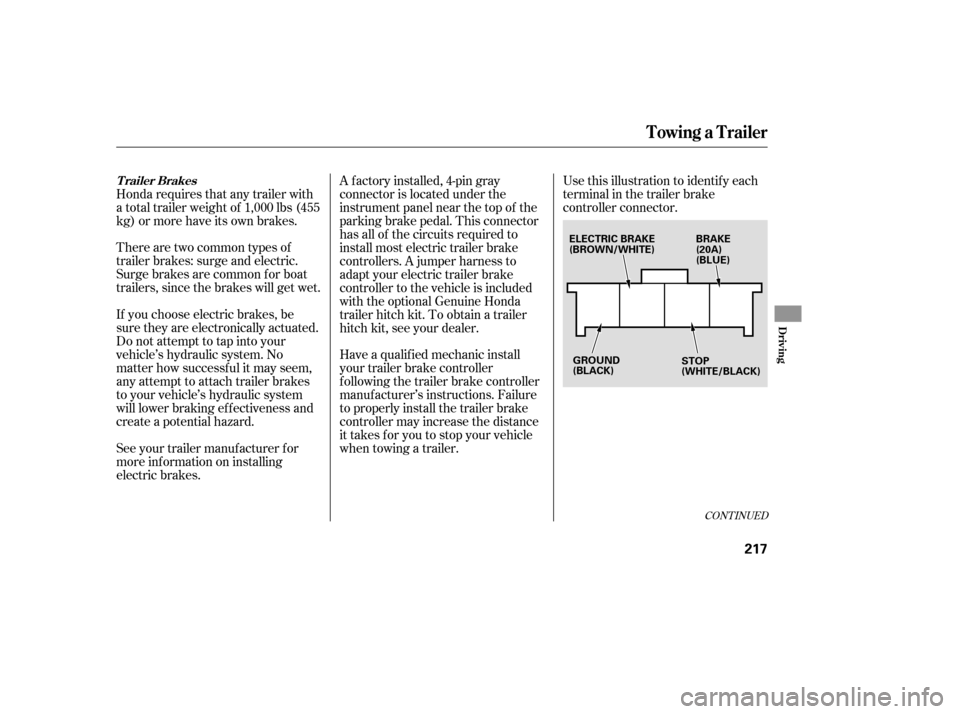Page 217 of 331

�µ�µ �µ Thebestwaytoconfirmthatall
loads
are within limits is to check
them at a public scale (see page
).
Add the weight of your trailer (as
quoted by the manufacturer) with
everything in or on the trailer. Then
check the tables on page to
make sure you do not exceed the
limit f or your conditions. To help ensure a saf e drive to a scale,
or if you cannot get to a public scale,
we recommend that you estimate
your total trailer weight and tongue
load as described.
The maximum
allowable weight of the vehicle, all
occupants, all accessories, all cargo,
and the tongue load is 6,050 lbs
(2,745 kg).
The GCWR must be reduced 2
percent f or every 1,000 f eet (305
meters) of elevation. The maximum
allowable weight of the f ully loaded
vehicle and trailer is 10,088 lbs
(4,575 kg) with the proper hitch. The maximum
allowable weight on the vehicle axles
is 3,105 lbs (1,410 kg) on the f ront
axle, and 3,245 lbs (1,475 kg) on the
rear axle. 212
214
Estimating Loads
Gross Vehicle Weight Rating
(GVWR)
Gross Combined Weight Rating
(GCWR) Gross Axle Weight Rating
(GA WR)
To Estimate the Total Trailer Weight
Towing Weight Limits
Driving
213
Page 218 of 331
�Î�Î�Î
�Î
�Î�Î
�µ�µ
Number of
Occupants 2
3
4
5 Max.
Trailer Weight Max. Tongue Load
Towing Weight Guidelines
214
Total Trailer Weight and Tongue Load Guidelines:
5000 lbs (2268 kg)
4750 lbs (2155 kg)
4750 lbs (2155 kg)
4500 lbs (2041 kg) 600
lbs (272 kg)
600 lbs (272 kg)
570 lbs (258 kg)
516 lbs (234 kg)
Recommended tongue load should be 5 15% of the total trailer weight for boat trailers, and 10 15% of the total trailer weight for all other
trailers. The corresponding weight limits assume occupants fill seats from the front of the vehicle to the back, each occupant weighs 150 lbs (70 kg),
and each has 15 lbs (7 kg) of cargo in the cab, pickup bed, or In-Bed Trunk. Any additional weight, including cargo or accessories, reduces
the maximum trailer weight and maximum tongue load. Never exceed the gross axle weight ratings (see page ). 213
Page 219 of 331
To accurately check your loads at
the public scale, the vehicle and
trailer should be f ully loaded, and all
occupants should stay in the vehicle
while the attendant watches the
scale.Check the f ront gross axle weight.
Limit: 3,105 lbs (1,410 kg) Check the gross vehicle weight.
Limit: 6,050 lbs (2,745 kg)
Check the weight of the hitched
trailer. Write this number down. Remember, maximum gross
combined weight should be
decreased 2 % f or every 1,000 f eet
(305 meters) of elevation. Check the gross combined weight.
Limit: 10,088 lbs (4,575 kg)
Remember, maximum gross
combined weight should be
decreased 2 % f or every 1,000 f eet
(305 meters) of elevation.
If you cannot weigh the rear axle
directly, you can calculate the rear
gross axle weight by subtracting
the weight in step 1 from the
weight in step 2.
Limit: 2,945 lbs (1,335 kg) Check the rear gross axle weight.
Limit: 3,252 lbs (1,475 kg)
1. 2.
3.
4.
5.
6.
Checking L oads
Towing a Trailer
Driving
215
Page 220 of 331

Check the weight of the unhitched
trailer. Limit: See page . Towing
generally requires a variety
of supplemen tal equipmen t. To
ensure the best quality, we
recommend that you purch ase
Honda equipment whenever possible.
Calculate the tongue load.
Subtract the weight in step 6 from
the weight in step 7.
Limit: See page .
Recommended: See page .Your dealer of f ers an optional trailer
package f or models other than RTX.
The package includes a hitch, a ball
mount, and a wiring harness.
Discuss any additional needs with
your trailer sales or rental agency,
and make sure all equipment is
properly installed, maintained, and
also meets state, f ederal, province,
and local regulations.
A weight distributing hitch is not
recommended f or use with your
vehicle, as an improperly adjusted
weight distributing hitch may reduce
handling, stability, and braking
perf ormance. Read the trailer manufacturer’s
instructions, and select the
appropriate draw bar f or the height
of the trailer you will be towing. We strongly recommend that you
have your dealer install a class 3
hitch. Using non-Honda equipment
may result in serious damage to your
vehicle.
7.
8. 212
214 214
All models except RTX
T owing Equipment and
A ccessoriesHitch
Weight Distributing Hitch
Towing a Trailer
216
Page 221 of 331

There are two common types of
trailer brakes: surge and electric.
Surge brakes are common f or boat
trailers, since the brakes will get wet.
If you choose electric brakes, be
sure they are electronically actuated.
Do not attempt to tap into your
vehicle’s hydraulic system. No
matter how successf ul it may seem,
any attempt to attach trailer brakes
to your vehicle’s hydraulic system
will lower braking ef f ectiveness and
create a potential hazard.
Seeyourtrailermanufacturerfor
more inf ormation on installing
electric brakes. Honda requires that any trailer with
a total trailer weight of 1,000 lbs (455
kg) or more have its own brakes.A f actory installed, 4-pin gray
connector is located under the
instrument panel near the top of the
parking brake pedal. This connector
has all of the circuits required to
install most electric trailer brake
controllers. A jumper harness to
adapt your electric trailer brake
controller to the vehicle is included
with the optional Genuine Honda
trailer hitch kit. To obtain a trailer
hitch kit, see your dealer.
Have a qualif ied mechanic install
your trailer brake controller
f ollowing the trailer brake controller
manuf acturer’s instructions. Failure
to properly install the trailer brake
controller may increase the distance
it takes f or you to stop your vehicle
when towing a trailer.Use this illustration to identif y each
terminal in the trailer brake
controller connector.
CONT INUED
Trailer Brakes
Towing a Trailer
Driving
217
BRAKE
(20A)
(BLUE)
GROUND
(BLACK)
ELECTRIC BRAKE
(BROWN/WHITE)
STOP
(WHITE/BLACK)
Page 228 of 331

The added weight, length, and
height of a trailer will af f ect your
vehicle’s handling and perf ormance,
so driving with a trailer requires
some special driving skills and
techniques.
Your vehicle tires and spare are in
good condition and properly
inf lated.
The trailer tires and spare are in
good condition and inf lated as
recommended by the trailer
maker.
The vehicle has been properly
serviced, and the tires, brakes,
suspension, cooling system, and
lights are in good operating
condition.
The trailer has been properly
serviced and is in good condition.
All weights and loads are within
limits.
Thehitch,safetychains,andany
other attachments are secure.
Allitemsonandinthetrailerare
properly secured and cannot shif t
while you drive. Towing perf ormance can be
af f ected by high altitude, high
temperature, or when climbing
steep grades. Theref ore, premium
f uel (premium unleaded gasoline
with pump octane number of 91 or
higher) is recommended when
towing more than 3,500 lbs (1,590
kg).
Foryoursafetyandthesafetyof
others,taketimetopracticedriving
maneuvers bef ore heading f or the
open road, and f ollow the guidelines
below.
Avoid towing a trailer during your
vehicle’s f irst 600 miles (1,000 km).
When preparing to tow, and bef ore
driving away, be sure to check the
f ollowing:
Driving Saf ely With a T railer
Pre-T ow Checklist
Towing a Trailer
Break-In Period
224
Page 235 of 331
Use a nylon strap to attach your
vehicle to the recovery vehicle, and
carefully take out the slack in the
strap. Once the strap is tight, the
recovery vehicle should apply force.
Re me mber that the recovery vehicle
needs good traction to avoid
becoming stuck, too.
You should never use a jack to try to
get unstuck. Your vehicle could
easily slip off the jack and hurt you
or someone else. You
may safely tow a trailer off-road
if you follow these guidelines:
Do not exceed the trailer weight
or tongue limits (see page ).
Stay on smooth, level dirt roads,
and avoid driving in hilly terrain.
Allow extra room f or starting,
stopping, and turning.
Slow down if you encounter bumps
or other obstacles. 214
Towing a Trailer Off-Road
Of f -Highway Driving Guidelines
Driving
231
Page 250 of 331

Oil is a major contributor to your
engine’s perf ormance and longevity.
Always use a premium-grade 5W-20
detergent oil displaying the API
Certif ication Seal. This seal indicates
the oil is energy conserving, and that
it meets the American Petroleum
Institute’s latest requirements.Honda Motor Oil is the pref erred
5W-20 lubricant f or your vehicle. It is
highly recommended that you use
Honda Motor Oil in your vehicle f or
optimum engine protection. Make
sure the API Certif ication Seal says
‘‘For Gasoline Engines.’’
The oil viscosity or weight is
provided on the container’s label.
5W-20 oil is f ormulated f or year-
round protection of your vehicle to
improve cold weather starting and
f uel economy.
Unscrew and remove the engine oil
fill cap on the valve cover. Pour in
the oil slowly and caref ully so you do
not spill any. Clean up any spills
immediately. Spilled oil could
damage components in the engine
compartment. Reinstall the engine
oil f ill cap, and tighten it securely.
Wait a f ew minutes, and recheck the
oil level on the engine oil dipstick.
Do not f ill above the upper mark; you
could damage the engine. Recommended Engine Oil
A dding Engine Oil
246
API CERTIFICATION SEAL
Ambient Temperature
ENGINE OIL FILL CAP